…a tiny white, newly hatched insect crawled from its nest in a twig of an oak tree and dropped to the ground. The nymph burrowed underground and found a rootlet of the mighty oak that stood above it to feed upon. It stayed underground growing and feeding on the roots of the tree, molting four times in the years that followed.
In the dark of night, during this very week in May (2011), the now amber colored nymph dug its way to the surface and crawled up the trunk of the same oak tree that it had dropped out of thirteen years earlier. Three feet above the ground the nymph stopped its ascent and held on to the bark of the tree with a vise-like grip. A short time later the nymph’s skin began to crack open along the back and a nearly all white, red-eyed creature emerged.
The soft-bodied insect crawled off to the side to dry. Its stubby wings began to unfold and lengthen and soon its white exoskeleton hardened into a satiny black finish. The veins of its transparent wings and its legs now had an orange tinge to them. It’s eyes were bright red-orange.
This creature wasn’t alone, millions of others of its kind where doing the same thing that night. This insect was, and is, part of what is known as Brood XIX, the Great Southern Brood, of Periodical Cicadas.
These cicadas are different from the green and coppery colored Annual Cicada that we see and hear each year here in North Carolina during the dog days of summer. They are smaller (the body is about 20-28 mm), sound different, and they are only seen above ground every thirteen years.
There are 15 different broods of Periodical Cicadas throughout the country. Twelve broods are 17 year cicadas and three broods, like the Great Southern Brood, are 13 year cicadas. The different broods may emerge at different times, in different years, but members of each particular brood all emerge within weeks of one another during the same year. There are exceptions, but generally that’s how it works.
There is much written about these cicadas. Three good resources which do a good job of explaining nearly everything you might want to know about periodical cicadas are listed here:
The University of Michigan Museum of Zoology
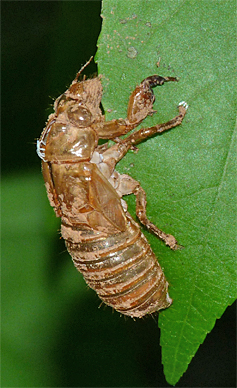
If our cicada (above) was lucky, it emerged intact, mated, deposited eggs in a twig fifty feet or so from where it had emerged from the ground and expired beneath that tree having completed its life cycle. Many cicadas don’t make it to reproduce, succumbing to fungus infections, being eaten by a bird, squirrel or chipmunk, or for one reason or other may not completely emerge from their nymphal skin or do not dry out properly resulting in deformed wings or incomplete body parts necessary for reproduction.
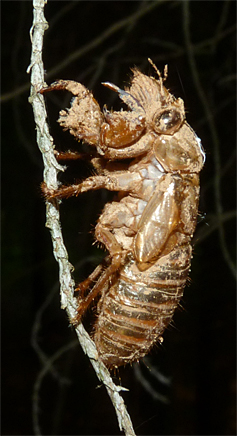
However, most do survive the ordeal of emergence and live to create a new group of cicadas to start the cycle anew. They will emerge again in the spring of 2024 here in North Carolina.
If you’re looking for cicadas in Durham, there seems to be more of them along the Eno River corridor, perhaps testament to the Eno River Association’s efforts to create a buffer from development along that very special river that flows through Orange and Durham Counties. If the land is disturbed due to development during the thirteen years that the cicadas are underground, they may be unearthed in the process.
Ranger Kristin spotted an exuvia here at the Museum about a week ago, but I’ve neither seen or heard adult cicadas to date. I’ve heard some at my home in Orange County but nothing like the numbers I saw and heard at Few’s Ford, Eno River State Park. Hundreds of exuviae and many adults were both seen and heard on May 11, just in the parking lot alone!
Below are more photos.
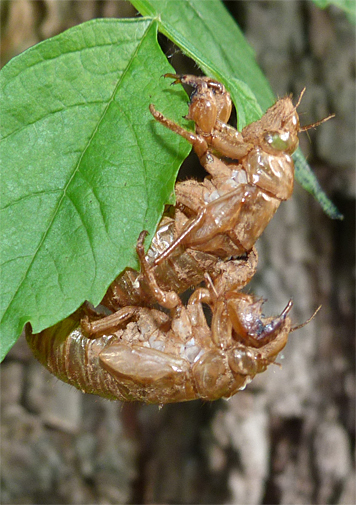
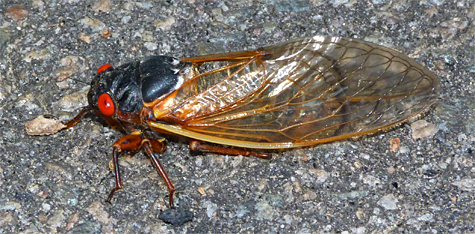
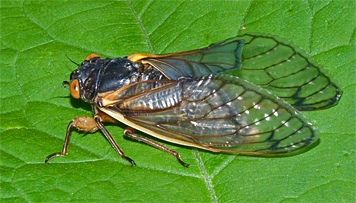
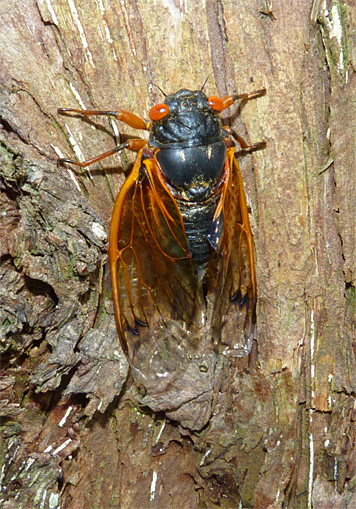
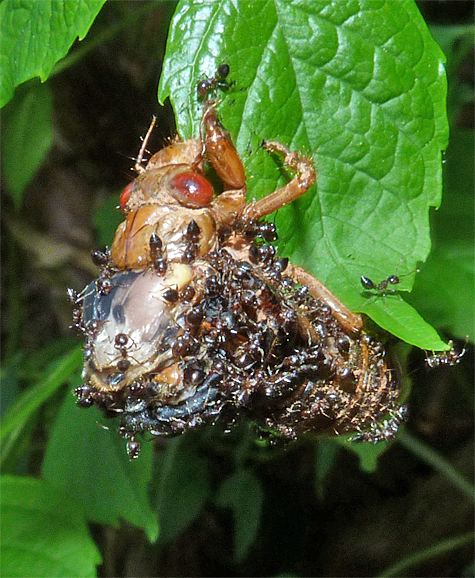
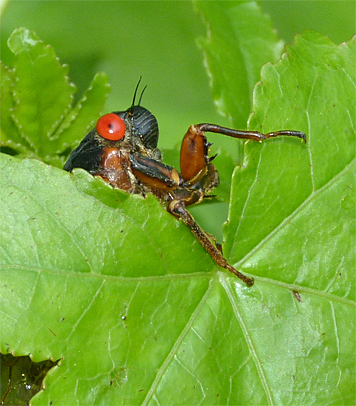
and one more…
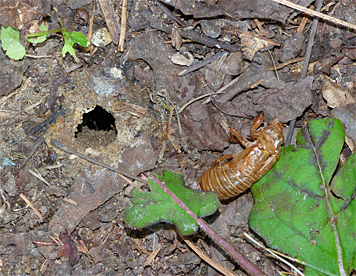
Happy hunting!
When will the cicadas leave?
The cicadas only live about two weeks. But, they don’t all crawl out of the ground at exactly the same time at the same location. Some were emerging in late April while others are still doing so now. I’m hearing more out in Orange County than I did a week ago but didn’t see or hear any when there were thousands calling and flying just five miles away.
The whole event lasts about 4-6 weeks at any given location, so if you’re hearing many more cicadas than you had previously,they’ve probably peaked and it will probably end soon.
Thanks,
Greg, I live just north of the Eno and we have have a ton of them around the yard. My daughter and the neighbor kids are having a ball checking them out. Have put their bug boxes to good use. It’s been a great educational experience for them.
Ashlyn,
I was down at Few’s Ford again on Sunday (Eno River Association Spring Picnic-5/22) and the cicadas were out in force, tons of them, as you say. It is indeed a great educational experience for the kids, and for the adults as well!
Thanks,
The sound is indescribable at our house, which is by the Pump House section of the River. It goes on every day from sunrise to late afternoon. And when you pick one up it growls at you!
Robin,
I went down to Few’s Ford again on Sunday morning (5/15/11), twice as many cicadas around!
The sound is somewhat indescribable, but I’ll try. It sounds like the flying saucer noise in the movies of the 50’s, but with a whole fleet of saucers hovering overhead. At least that’s the noise of the species which was overwhelmingly present at Few’s Ford, which I assume is the same where you are.
There were lots of people coming and going (Sunday hikers) and everyone remarked about the sights and sounds of the cicadas, it’d be impossible to ignore it. Some seemed actually annoyed. To me, it was very, very exciting! I wanted to stay there all day and listen and look at them.
So many stories were unfolding, from predation, failure of some of them to emerge properly. You could see where there were many more cicadas where the older trees were and which had been the cicadas’ birthplace many years ago and where there had been hundreds of cicadas tunneling up from the ground below the trees that they hatched from. Areas where there were no trees, of course had no or very few cicadas.
Anyway, very exciting.
Ranger Greg…I loved your description of the cicada’s 13 year journey and pictures! (I’m looking up Few’s Ford Eno River State Park on my Durham map just to check out that parking lot.) Thanks!!!
Thanks DJ.
I think that anywhere you go along the Eno you’ll likely see the cicadas, although the exuviae will probably be washed off the vegetation by all of the heavy thunderstorms we’ve been experiencing the last few days. Hopefully more cicadas will be busting out of the ground tonight and a check of the area tomorrow will yield some new arrivals.
By the way, Few’s Ford is at the very end of Cole Mill Road. The road ends at the park entrance.
Good luck!!
Great story, Greg. You make the drama of their life cycle so very real and personal. I was able to get some good photos of the emergence when I visited Georgia few weeks ago. It was quite a treat to catch them in action. You can see them at http://southenglishtown.blogspot.com/2011/04/once-every-thirteen-years-great.html
Wonderful photos Wilma, and thanks for the kind words.
I urge everyone to check out Wilma’s blog (above) and have a look at her photos of the cicadas emerging.
Enjoy!
This has been a really cool event (unless you live near the park!). I sent you some photos of the adult emerging process and am putting more on my Flickr site. Another good place to find information and report on what you see is http://www.magicicada.org.
Thanks Richard. You’re right, it is a cool event. I remember when they emerged back in ’98, at that time I was able to get some nice video and audio, quite incredible!